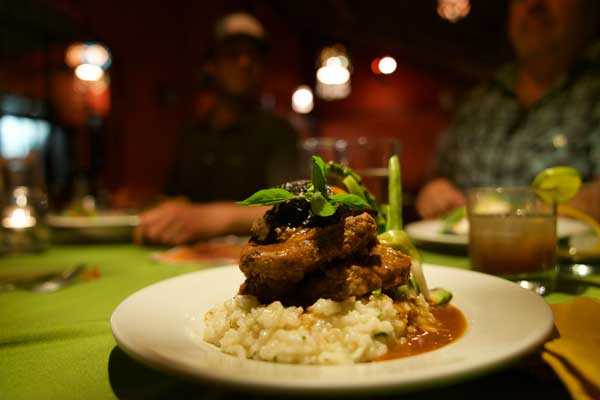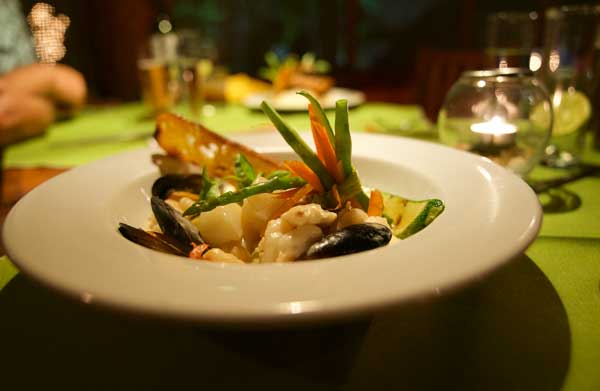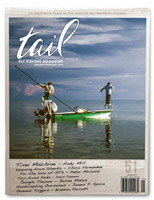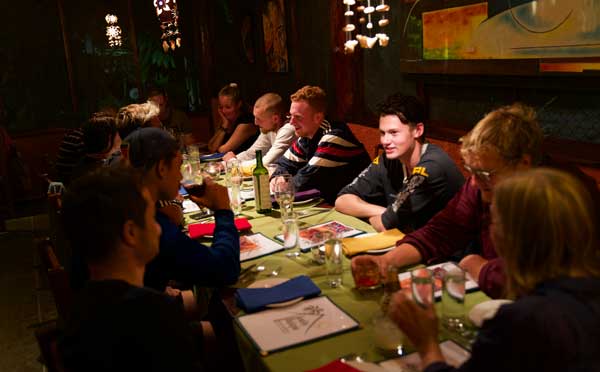The Leaky Palapa Restaurant (leakypalaparestaurant.com) dishes up gourmet cuisine that would earn acclaim anywhere. But when you consider that the restaurant is located in the Caribbean fishing village of Xcalak—population 400, paved roads, zero—the plates coming out of the Leaky Palapa’s kitchen border on miraculous.
Chef Marla Stiles and her wife Linda Loo have been feeding locals, expat Americans, and snowbirds at the southern end of the Mexican Yucatan since 2004. With fly fishers descending on Xcalak in growing numbers, the Leaky Palapa has gained a reputation among saltwater bug-flingers as a gastronomic attraction that’s as irresistible as the area’s bonefish and permit.
“I’ve lived and traveled all over the world and have eaten at some of the best restaurants in some of the foodiest cities, and the Leaky Palapa is in my global top ten,” says Rob Mukai, a Utah native who runs the Acocote Eco Inn a few miles north of town. “They would be competitive in Tokyo, London, New York, Sydney—you name it.”
Veteran restaurateurs from Canada, Stiles and Loo have crafted a menu that merges Mexican culinary traditions with French and Italian techniques, elevating customary Yucatecan ingredients and flavors from delicious to magnificent. The food remains familiar and approachable while simultaneously inspiring admiration and wonder. The portions are satisfying, the prices shockingly reasonable.
The Leaky Palapa balances refined fare with a casual atmosphere. Situated on the ground floor of its owners’ home, it radiates a warmth that isn’t merely the result of its tropical locale. Guests rarely enter without a cheerful greeting and a hug. The cozy dining room’s garnet-hued walls, dimly lit by small lights encased in gourd lampshades, create a mood that’s as inviting as the proprietors.

Loo runs the front of the house and tends the bar. Her signature cocktail is the chile-pineapple margarita, in which sweet, sour, and picante mingle in salt-rimmed glasses—but she’s just as deft at crafting classics like the old fashioned or recommending a bottle from the wine list.
The libations are useful lubricants to help with the diner’s difficulty of deciding what to order. From appetizer through dessert, everything on the menu is intriguing. Popular main dishes include pasilla chile-crusted pork tenderloin with a bourbon and ancho reduction; ravioli filled with huitlacoche, a mushroom-like corn fungus that’s sometimes called Mexican truffle; and the pork ossobuco, slow-roasted with a chipotle tomato broth until it peels off the bone.
Being about three or four long casts from the edge of the Caribbean Sea, the Leaky Palapa naturally excels with seafood. Besides the Campeche shrimp that’s dusted with dried chiles and served atop squid-ink pasta, the restaurant’s fish and lobster come from speargun-wielding Xcalak fishermen. Whether it’s the local spiny lobster tails (grilled on the barbecue or poached in coconut milk) or one of Stiles’ myriad fish presentations, there’s a good chance the food on your plate was still swimming earlier in the day.
(If there’s a can’t-miss appetizer on the menu, it’s the caramelized ginger-seared lobster bites. The lobster is divine by itself, but the sauce that pools around it has caused diners to forsake their manners. “Somebody told me I should serve a squeegee with this thing,” Loo says, “so you don’t leave anything on the plate.”)
It’s no wonder the Leaky Palapa is a favorite hangout of traveling fly anglers. From across the globe, they descend on Xcalak as a home base for guided and DIY trips to Chetumal Bay’s flats, the area’s intricate lagoon systems, and beachfront fishing inside the Mesoamerican Reef. Fly fishing travelers, Stiles says, account for about 40 percent of the Leaky Palapa’s business.
As far as it is from Cancun, Xcalak attracts a different kind of traveler than the all-inclusive resorts on the northern Yucatan beaches or the full-service fly fishing lodges around Ascension Bay to the north or Belize’s Ambergris Caye to the south. People visit Xcalak to get away from crowds. If they’re not in search of bonefish, permit, tarpon, and snook, they’re likely looking for solitude on the Costa Maya’s sparsely populated beaches, or seeking underwater adventure via snorkeling or scuba diving. That’s how Loo and Stiles stumbled onto Xcalak while escaping the Canadian winter in January of 2004.
“We were camped on the beach in a motorhome we picked up in Texas,” Stiles says. “We had been traveling through Mexico, camping on beaches and diving. We had all our equipment plus a compressor, as well as an inflatable diveyak. An American couple whose daughter owned a place in town came by our campsite to ask if we would be interested in renting the space and operating a restaurant.”
Stiles and Loo returned to the Great White North, sold their house and restaurant in London, Ontario, and went back to the tropics on a somewhat impulsive, unplanned adventure to open a restaurant in a tiny Mexican fishing village on the edge of the Caribbean. “Once we made the decision, it was easy,” Loo says.
Starting a new restaurant in remote Xcalak wasn’t as easy as the decision to do it. The restaurant’s first space consisted of a small building with a tiny apartment, a cramped kitchen, and a larger open area for the restaurant covered by a palapa, a classic Mexican shelter with a palm-leaf thatched roof.
“We had rented this building without looking at it very carefully,” Stiles says. “While sitting inside the palapa making our plans, we looked and realized we had a large problem: The palapa needed replacing, and we didn’t have the cash to do it. So we thought for a minute and we decided, no problem: We would buy a bunch of umbrellas and put them over each table and call it the Leaky Palapa.”
At the time, Xcalak’s electricity was supplied by a generator that ran for three or four hours a night and rarely at full power. Fate intervened in the form of CFE, Mexico’s state-owned electric utility, which installed transformers and put Xcalak on the electrical grid just as Stiles and Loo were set to open in October 2004.

There also were problems stocking the restaurant’s larder. Xcalak has no grocery stores, too small even for the type of central mercado that’s ubiquitous in many Mexican cities. Local fishermen kept the restaurant stocked with fish and lobster, but other ingredients were hard to get. Grocery trucks came in from bigger towns a couple times a week, but supplies were limited and their schedules unreliable. Stiles and Loo had to make weekly trips to Chetumal, a five-hour round trip drive—with no guarantee vendors would have needed ingredients.
“It was crazy some days,” Loo says. “We’d get to Chetumal, and there wouldn’t be any lettuce.”
The Leaky Palapa staggered forward nine years in its original space. Loo and Stiles found relief for their stress by kayaking back in the bay, fishing and camping and watching roseate spoonbills, crocodiles, and wood storks. Being accepted and welcomed by the local community, and seeing their customers’ reactions to their restaurant, made it worth the frequent hassles.
In 2013 they finished construction on a new home and restaurant, where they serve customers Thursday through Sunday between US Thanksgiving and late April. The restaurant closes during the low season while Loo and Stiles return to Canada.
They still face hardships operating a restaurant of the Leaky Palapa’s caliber in a remote corner of the Mexican Caribbean, but it’s easier than it used to be. They built the new digs with a dining room and kitchen closer to their specifications. They still make weekly five-hour round-trip drives to Chetumal for ingredients, but Quintana Roo’s capital city now has a Walmart, a Sam’s Club, and the large Mexican grocery chain Chedraui. Electricity is more reliable these days, although Stiles and Loo still turn to a backup generator at times. The salt and humidity are hell on kitchen equipment. But the force that propels the Leaky Palapa and its owners forward is the same thing that makes the restaurant so remarkable: It’s the challenge of creating something extraordinary where you least expect it. When people respond to that, it’s the stuff of dreams.
“The best thing about running a restaurant here is the people,” Stiles says. “Our customers come from all over the world. They have worked all year for their holiday, and now they are on it. They are in the best frame of mind, as they are here doing what they love and what gives them joy.”
For many Xcalak visitors, that includes dining at the Leaky Palapa.
Bio: Trey Reid has written for numerous newspapers, magazines, and websites, and is a former field reporter for ESPN. He works in public and media relations for the Arkansas Game and Fish Commission, producing and hosting the agency’s television show Arkansas Wildlife. He also hosts the outdoor radio show The Wild Side on 103.7 FM The Buzz in Little Rock, which can also be heard as a podcast.
Photos: Trey Reid, Michael DeJarnette, Bob Haines, Lee Reddmann, and Kaettie Wenger
RELATED ARTICLES:
 SUBSCRIBE TO TAIL FLY FISHING MAGAZINE
SUBSCRIBE TO TAIL FLY FISHING MAGAZINE
SALTWATER FLY FISHING


